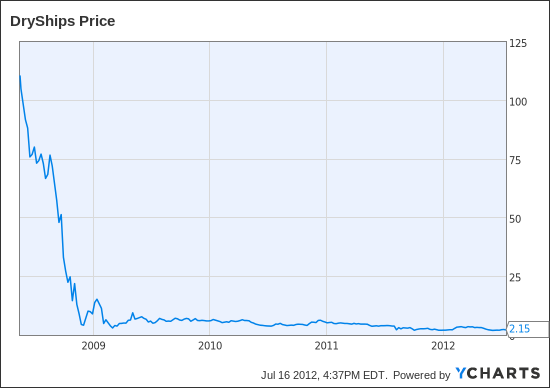On May 16, 2008, DryShips
And then something terrible happened:
DRYS data by YCharts
Shiver me timbers! DryShips threw its dividend overboard, lost 98% of its share price value, and is currently trading at only $2.16. This company was certainly hit hard by the recession, but why hasn't it rebounded after four years?
Shipping ain't what it used to be
DryShips' initial decline had more to do with macroeconomics than mismanagement. Prior to the recession in late 2008, there was huge demand for "dry bulk" goods, which are commodities like cement, coal, and iron ore. With demand outweighing total shipping capacity in the first quarter of 2008, DryShips on average earned premium daily rates of more than $63,000 per vessel and purchased seven more ships for more than $770 million in order to meet increased demand.
After the economic downturn, the global demand for dry bulk decreased, and DryShips started canceling its new vessel acquisitions. This caused daily rates to plummet, and today DryShips earns 65% less in revenue per dry bulk vessel per voyage than it did four years ago. This lower rate has taken a heavy toll on the bottom line and contributed to the company's net losses of $70.1 million in fiscal 2011 and $47.5 million in Q1 of this year.
Did other companies walk the plank?
DryShips' main competitors, Diana Shipping
|
Company |
Closing Price -- May 16, 2008 |
Closing Price -- July 16, 2012 |
Cash-to-Debt (MRQ) |
Debt-to-Equity (MRQ) |
|---|---|---|---|---|
| DryShips | $110.74 | $2.16 | 0.04 | 112.83 |
| Diana Shipping | $39.00 | $6.99 | 1.12 | 31.97 |
| Navios Maritime Holdings | $14.67 | $3.33 | 0.11 | 126.54 |
Source: Yahoo! Finance. MRQ = most recent quarter.
The share prices of all three have taken a beating, and DryShips' and Navios' cash-to-debt ratios, at 0.04 and 0.11, respectively, make both stocks very risky investments. Diana Shipping, with a cash-to-debt ratio of 1.12 and a debt-to-equity ratio of almost 32, seems to have a manageable debt load and may look appealing, but is any company in the shipping industry a safe investment right now?
Jump ship
The Baltic Dry Index, which measures the global demand for bulk shipping versus the amount of shipping capacity that is available, is a good way to check the pulse of this sector. It sits at a lowly 1,102 points, a more than 90.7% drop compared to its all-time high in May 2008. Furthermore, a contracting European economy, weak U.S. economy, and recent evidence that China is also slowing down don't bode well for the future of dry bulk shipping.
Look for buried treasure in a different industry
This may have been a dynamic and exciting sector four years ago, but sometimes it's better to invest in more stable, long-term exchange-traded funds. To illustrate this point, let's compare the total return prices since 2008 for DryShips, Diana, Navios, and the SPDR S&P 500
DRYS Total Return Price data by YCharts
If this chart could talk, it would say: "Boring is sometimes better." These Greek shipping companies, much like the Greek economy, have been tanking. Exchange-traded funds like the SPDR S&P 500 won't make you a millionaire overnight, but they will help you to grow your wealth long-term.
If you're interested in exploring other exchange-traded funds, our analysts have selected three solid picks that will buoy your portfolio. Read this special FREE report today by clicking here: "3 ETFs Set to Soar During the Recovery."



